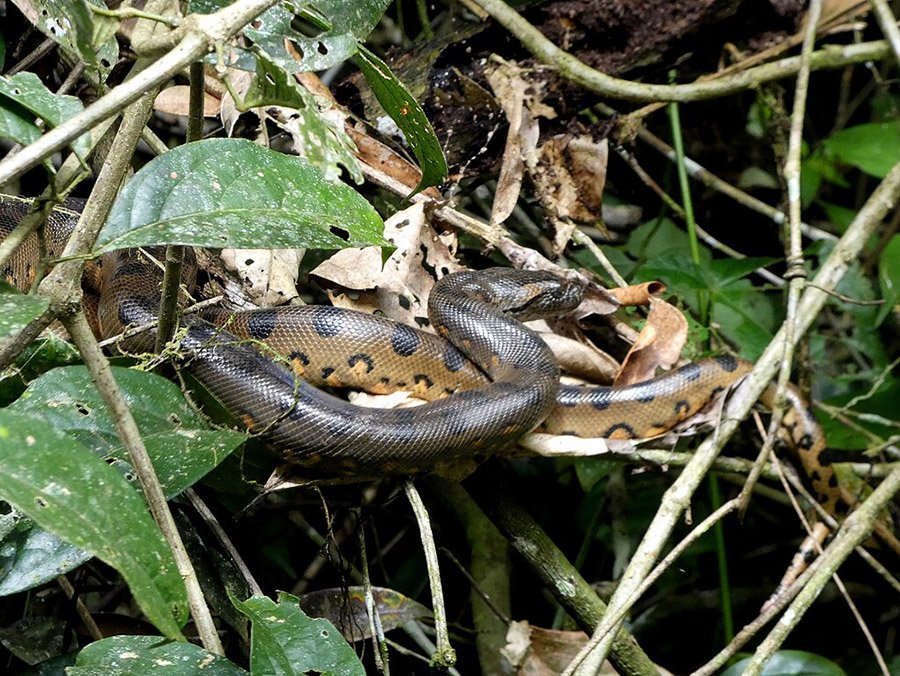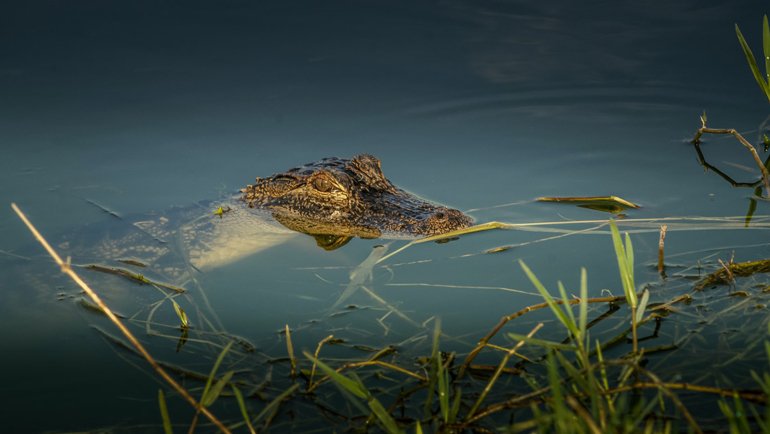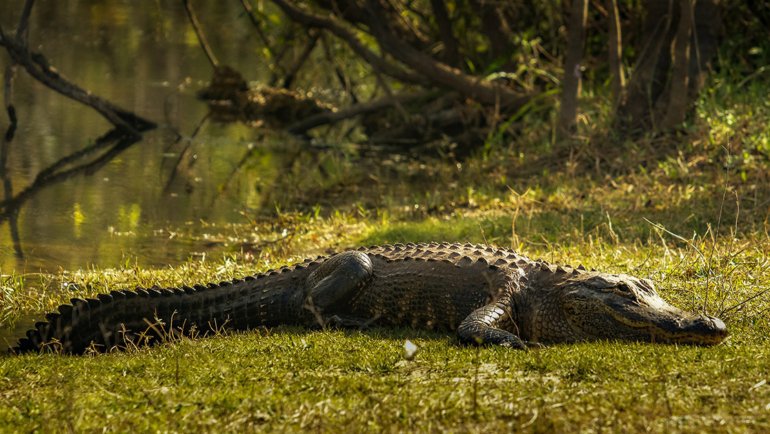Often feared and revered, the anaconda stands as one of the most iconic snakes in the world, not merely for its size but also for its notable presence in the South American ecosystem.
The term “anaconda” often evokes images of an enormous, powerful snake gliding effortlessly through murky waters, its eyes scanning the surface for its next meal. Yet beyond these impressions lie a complex creature with distinct habitat preferences and a significant role in its ecosystem.
Species of Anacondas
When one speaks of the anaconda, it’s usually the Green Anaconda that comes to mind, given its status as the heaviest and one of the longest snakes in the world. However, the anaconda name actually encompasses several species, each with its unique characteristics and habitats:
- Green Anaconda (Eunectes murinus): This is the largest of the anaconda species and is typically found in the swamps, marshes, and slow-moving streams of the Amazon and Orinoco river basins.
- Yellow Anaconda (Eunectes notaeus): Slightly smaller than its green counterpart, the Yellow Anaconda resides predominantly in the Paraguayan Pantanal and other regions of Brazil, Bolivia, Paraguay, and northern Argentina.
- Bolivian Anaconda (Eunectes beniensis): As the name suggests, this species primarily finds its home in Bolivia’s northeastern regions, especially in the department of Beni.
- Dark-spotted Anaconda (Eunectes deschauenseei): The smallest of the group, the Dark-spotted Anaconda is native to northeastern South America, primarily in regions of northern Brazil and French Guiana.
 Source: Wikimedia Commons
Source: Wikimedia CommonsGeographical Distribution
Anacondas are distinctively South American reptiles, thriving in a range of environments from the dense Amazonian rainforests to the wetlands of the Pantanal.
Their distribution, while broad, is concentrated within specific ecological niches that provide them with the necessities for survival. South America is the continent where anacondas reign, they are deeply rooted in its ecosystems.
- Brazil: The Amazon rainforest, one of the largest tropical forests in the world, offers the lush, wet environment these snakes thrive in.
- Venezuela: Here, the Orinoco River Basin provides ample habitat, especially for the Green Anaconda.
- Colombia and Peru: These countries, along with Brazil and Venezuela, encompass the vast Amazon basin, home to many of the snake’s populations.
- Bolivia: While it houses a fraction of the Amazon rainforest, it’s primarily known for the presence of the Bolivian Anaconda in its Beni department.
- Paraguay and Northern Argentina: These regions, especially the wetlands of the Paraguayan Pantanal, are prime territories for the Yellow Anaconda.
- Guyana and Trinidad and Tobago: These locations, while not the primary habitats, still report sightings and have suitable environments for anacondas.
Preferred Habitats of Anacondas
The anaconda’s preference for watery realms is well-documented. Their muscular, sinuous bodies are adept at navigating both land and water, but their hunting, mating, and even birthing often occur in or near aquatic locales.
Freshwater Wetlands: Marshes and swamps with their slow-moving waters and abundant prey are a haven for anacondas. The stillness of the water allows them to stealthily approach prey or lie in wait for an unsuspecting meal.
Rainforests: The Amazon rainforest, with its intertwining rivers and flooded forests, provides an ideal shelter and hunting ground. The canopy’s shade, combined with the forest’s humidity, creates the perfect temperature and environment for these cold-blooded reptiles.
Rivers and Lakes: Anacondas are remarkable swimmers. They utilize rivers and lakes both as hunting grounds and as a means of transportation. The aquatic environment offers them camouflage, and the water supports their massive bulk, making movement more effortless.
Factors Influencing Habitat Choice of Anacondas
The vast terrains of South America provide diverse habitats, but anacondas are selective, and driven by specific needs and instincts.
Prey Availability: Central to any predator’s habitat choice, anacondas seek regions teeming with prey—fish, birds, mammals, and even other reptiles. Wetlands, with their thriving ecosystems, naturally become a top choice.
Temperature and Climate: Being ectothermic, or cold-blooded, anacondas depend on external sources to regulate their body temperature. The warm, humid environments of rainforests and wetlands provide the optimal thermal conditions they need for metabolism and activity.
Safety and Shelter: Anacondas require habitats that offer concealment from potential threats, especially when they are young or during the vulnerable moments of shedding skin. The dense vegetation of rainforests and the murkiness of freshwater habitats offer such sanctuary.
Mating Grounds: Water bodies become especially important during the mating season. These areas serve as gathering grounds, where multiple males may vie for the attention of a single female.
Threats to Anaconda Habitats
As with many wild creatures, anacondas face mounting challenges brought on by human activities and environmental changes.
Deforestation: The rapid clearing of rainforests for agriculture, logging, and urban development reduces the natural habitats of anacondas. As forests recede, the intricate balance of the ecosystem gets disrupted, affecting both the snakes and their prey.
Pollution: Water pollution, especially from industrial activities and mining, contaminates the freshwater habitats where anacondas thrive. Toxic chemicals can directly harm the snakes or reduce the number of prey, forcing the anacondas to migrate or face starvation.
Urbanization: The encroachment of human settlements often leads to human-snake conflicts. Misunderstood and feared, anacondas may be killed on sight, especially if they venture close to populated areas.
Climate Change: Alterations in temperature, rainfall patterns, and the frequency of extreme weather events can impact the habitats and behavior of anacondas. As wetlands dry up or rainforests experience unusual droughts, the ripple effects can be profound on the snake populations.
Conservation Efforts
Preserving the habitats of anacondas is not just about saving the snakes; it’s about ensuring the health and balance of whole ecosystems.
Protected Areas: Numerous national parks and reserves across South America have been established to conserve pristine rainforests and wetlands. These protected zones serve as refuges for anacondas and countless other species.
Community Initiatives: Grassroots organizations and indigenous communities play a pivotal role in conservation. Their efforts, from reforestation to ecotourism, have a lasting impact on the ground.
International Collaboration: Conservation is a global effort. International bodies and NGOs collaborate with local governments to fund and implement conservation projects, research, and awareness campaigns.
Frequently Asked Questions
Are anacondas dangerous to humans?
While anacondas are apex predators, they rarely see humans as prey. Most encounters with humans are non-confrontational. However, like any wild animal, they can become aggressive when threatened.
How long can an anaconda grow?
The Green Anaconda, the largest species, can grow up to 29 feet, though most are between 10 to 20 feet. Other species are generally smaller.
Do anacondas have any natural predators?
Young anacondas can fall prey to caimans, large birds of prey, and other large carnivores. Adult anacondas have few natural predators, but they can sometimes face threats from jaguars.
How often do anacondas eat?
Their feeding frequency depends on the size of their last meal. After consuming a large prey, an anaconda might not eat for weeks or even months.
Can anacondas be found outside of South America?
While they are native to South America, there have been occasional reports of anacondas in Florida, likely due to the exotic pet trade. However, they are not established as an invasive species there.
Learn More About Anacondas
- Anaconda: Characteristics, Diet, Facts & More [Fact Sheet]
- How Fast Are Anacondas? How Do They Compare With Other Snakes?
- Can Anacondas Swim? Are They Good Swimmers?
- Are There Anacondas in Florida? Unraveling the Mystery
- Anaconda vs. Python: Giants of the Snake World
- Do Anacondas Lay Eggs? Understanding Anaconda Reproduction
- 25 Super Interesting Facts About Anacondas
- Titanoboa vs. Anaconda: A Comparison of the Colossal Serpents


